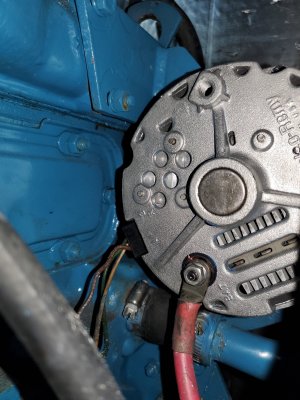Tony Aragon
New Member
Dear members, this is my first post, but I have been a morgan owner and followed this forum for several years. I need some insight from the collective knowledge of this group. I just changed my battery bank to 4 x 6V trojans (flooded) for the house and a 12V 120amp starter. After I finished the installation, I went out and 3 minutes later in the middle of the kemah outlet my Viking battery monitoring system alarm accused over voltage of 15.9V on my battery bank. Since I was in the middle of the channel alone and could not turn off the motor, I decided to disconnect my alternator with the motor running to spare the batteries from the overcharge. This cooked my alternator. My initial thoughts were that my alternators internal voltage regulator was the problem. (I still believe this alternator has an internal voltage regulator correct?)
took it to an alternator specialist and he confirmed it was cooked and did a complete rebuild and tested the alternator. I still use the original delco (60 to 80amp) that came with my perkins 4108.
Went back to my boat and after reading several forums, thought the problem was my hook up of the Blue Sea System SI-ACR Automatic Charging Relay that was connected to the same distribution block as the alternators charging port. Changed the outlet of the ACR directly to the battery post as advised in a post and tested again. With the motor on and just taking the RPM to 3000, the voltage did not go over 14V. Thought problem was solved.
Left yesterday to Florida and again the same problem happened as soon as I left the marina. After putting in gear and accelerating the over voltage came back taking the voltage up to 16V. This time I had time to turn off the motor and disconnect the alternator and continue, since I would be in a marina to charge my batteries with the AC power charger.
Can not understand what I did wrong. Below a diagram of my set up. Some help and knowledge would really be appreciated before spending money on a specialized electrician.
Thanks for any input.
took it to an alternator specialist and he confirmed it was cooked and did a complete rebuild and tested the alternator. I still use the original delco (60 to 80amp) that came with my perkins 4108.
Went back to my boat and after reading several forums, thought the problem was my hook up of the Blue Sea System SI-ACR Automatic Charging Relay that was connected to the same distribution block as the alternators charging port. Changed the outlet of the ACR directly to the battery post as advised in a post and tested again. With the motor on and just taking the RPM to 3000, the voltage did not go over 14V. Thought problem was solved.
Left yesterday to Florida and again the same problem happened as soon as I left the marina. After putting in gear and accelerating the over voltage came back taking the voltage up to 16V. This time I had time to turn off the motor and disconnect the alternator and continue, since I would be in a marina to charge my batteries with the AC power charger.
Can not understand what I did wrong. Below a diagram of my set up. Some help and knowledge would really be appreciated before spending money on a specialized electrician.
Thanks for any input.


